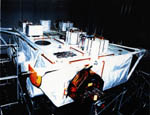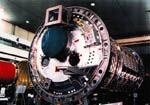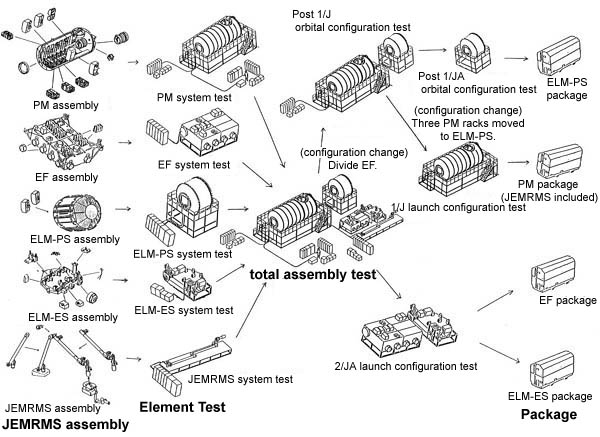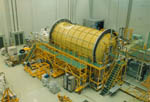|

| Promoting Kibo development |
|
-
| The
Kibo development process is divided into three stages: Basic development test
stage, Engineering Model (EM) production and test stage, and Proto Flight Model
(PFM) production and test stage. | | (1) | Development and
basic test stage | | During the development
and basic test stage, a full-scale mockup or Breadboard Model (BBM) is developed
to obtain necessary data. The purposes of this stage are to examine the structure
which is important for development, to study functions of electronic circuits,
and to confirm whether the basic design specification is appropriate or not. A
breadboard model is a simplified model which utilizes general purpose parts or
materials, not intended for space.
 |
| Accessibility evaluation test by a mockup |
| | (2) | EM production and test stage | | During
the EM production and test stage, mechanical and electrical design specifications
and test procedures are established, and an engineering model, which resembles
a proto flight model, was built in order to establish production procedure and
useful data were obtained. During approved model tests, conditions severer than
in actual operation were imposed so that any hidden design faults might be discovered.
As stated above, during the EM production and test stage, the design and production
procedure were confirmed to be suitable for producing hardware and software compatible
with engineering requirements. From this stage, Kibo development entered the PFM
production and test stage. With the end of the total system test held in Tsukuba
Space Center in Oct. 1998 which integrated all the components, all of the EM production
and test stage activities were completed.
 |
| EF Engineering Model |
| | (3) | PFM production and test stage | | During
the PFM production and test stage, actual models to be attached to ISS will be
manufactured. In this stage, various tests will be conducted in conditions simulating
the actual operation environment, to confirm that an actual flight model manufactured
according to the design specifications and to the manufacturing procedure established
on the EM stage has no material defects or manufacturing procedure problems.
 |
| Proto Flight Model or PFM of Kibo's PM | |
 |
Flight Model Manufacture, Assembly
and Test Procedure |
| A
component will be manufactured and completes series of tests as a flight model.
The components will be assembled to form an assembly unit and each assembly unit
will then be subjected to an assembly unit test. The assembly units will then
be connected to establish Kibo elements, and each element will be subjected to
tests in which they will be inspected to prove that they have no problems as flight
models.
After each element is inspected, Kibo elements will be gathered
at Tsukuba Space Center and be mated in the on-board Kibo configuration in order
to check total system functions and performance.
After total system tests
are completed, the following tests will be conducted in the launch configuration.
Tests will be conducted in the launch configuration since Kibo is going to be
launched to orbit by three separated Space Shuttle flights. When all tests are
completed, the next event is the launch. Each element will be packaged and transferred
to Kennedy Space Center in the US.
|
 |
| PFM total system assembly and test flow |
Produce
two identical models? Kibo development process
| We spent three years conducting the basic
design to ensure Kibo would be 100% capable in space. Since each part is complicated
and must be precisely designed, we need to conduct the design with special care
even after the basic design has been finished. First, an EM which has structure
almost identical to that of the actual model is being manufactured and tests are
repeated. Based on the tests results, a flight model for actual space use will
then be designed. Even after its production, further tests will be conducted. |
 |
| Engineering model being manufactured and tested thoroughly. |
|
| | |  |
Launch in 2006 and 2007
| |
Last Updated : Oct, 31, 2002
|
